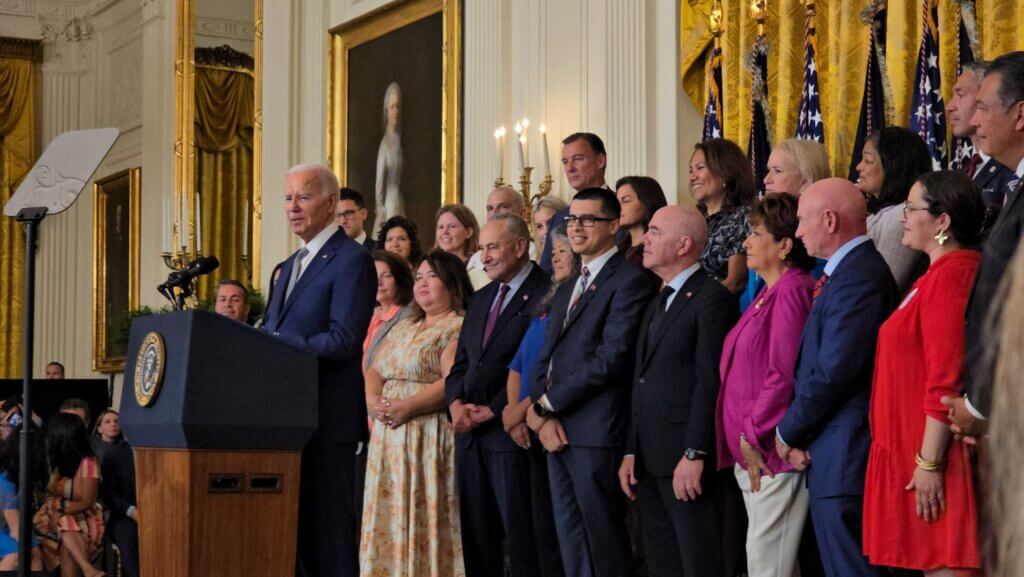This Week in Immigration Reform

Week Ending October 28
This week in immigration: USCIS announces new fee schedule and guidance on ‘extreme hardship’; new report shows benefits of DACA extend into communities across the country.
USCIS issues new fee schedule: U.S. Citizenship and Immigration Service (USCIS) published a final rule adjusting the fees required for most immigration applications and petitions. The new fees will be effective December 23, 2016 and there is an average 21 percent increase in most application fees. The fee rule has been made final after USCIS reviewed stakeholder feedback. During the comment period earlier this year, NCLR expressed disappointment at the increase of fees, but was encouraged by the creation of a new partial fee waiver.
One of the results of the final rule is a new three-level fee system for the application for naturalization (Form N-400). The standard fee will increase from $680 to $725 (including biometrics). USCIS will introduce a partial fee waiver that will apply to applicants with household incomes between 150-200 percent of federal poverty guidelines, or between $36,000-$48,000 per year (for a household of four). The full fee waiver for applicants with household incomes under 150 percent of poverty will remain in effect. Professor Manuel Pastor, Director of the Center for the Study of Immigrant Integration (CSII) at the University of Southern California, estimates that there are 1 million legal immigrants who will be eligible for the new partial naturalization fee waiver, and 2.7 million immigrants who are eligible for the full naturalization fee waiver.
USCIS will host a conference call to answer questions regarding the final rule on November 2nd at 3:30 Eastern. To register for the USCIS call with Director Rodriguez, click on the USCIS registration page and follow the instructions.
USCIS clarifies extreme hardship standard: USCIS also released its final guidance to clarify how it determines whether an individual’s family will experience “extreme hardship” if the individual is denied admission to the U.S. This guidance will go into effect on December 5, 2016. The American Immigration Council posted a good summary of the new policy guidance which is excerpted below:
The guidance clarifies the steps that must be taken to adjudicate an extreme hardship waiver and provides a list of factors that USCIS may consider when making a determination. The applicant has the burden of proof to demonstrate by “a preponderance of the evidence” that he or she satisfies all requirements for the waiver. This means proving the necessary family relationships and detailing the exact nature of the hardship. The guidance further clarifies that to be considered “extreme,” the hardship must exceed that which is usual or expected and must go beyond that typically associated with deportation.
The guidance includes a lengthy list of social, cultural, economic, health, and other conditions that may be considered relevant. USCIS is supposed to examine the totality of the evidence to make a hardship determination. For example, hardship to multiple qualifying family members might rise to the level of extreme hardship even if no single qualifying relative alone would suffer hardship enough to be determined “extreme.”
New report on DACA demonstrates the positive impact on communities across the country: A new report released by the Center for American Progress, the National Immigration Law Center, and United We Dream highlights the reports of the survey conducted by University of California, San Diego, professor Tom Wong of more than 1,000 beneficiaries of the Deferred Action for Childhood Arrivals, or DACA, program. The survey results show that those who received work authorization through the Obama administration’s executive actions have improved their economic situation, stimulated the economy, and become breadwinners for their families. DACA has shown that it is not only beneficial to the individuals who have had their applications approved, but that it has had an effect on local economies as DACA recipients contribute even more in federal, state, and local tax revenues.



